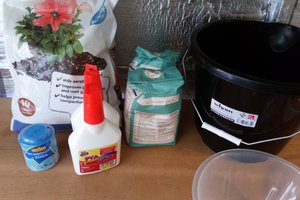As my pint of commercial etchant reached the end of its useful life I began to wonder if I could make my own. The commercial stuff works well enough, but it costs an arm and a leg. I paid $20 for 500 ml (that's about pint for you non metric folks). Plus I have to drive 400km or 250 mi (which ever comes first) to get it. So I thought maybe I should give chemistry a try. How hard could it be ? Turns out not very hard at all.
I have seen people try to etch with the following four solutions:
vinegar and peroxide
hydrochloric acid and peroxide
home brewed ferric chloride
cupric acid
White vinegar is about 5% acetic acid, and when it is mixed with an equal part of 3% hydrogen peroxide it is supposed to make an efficient etchant. This may work if you have a few days to kill. I tried it, and after six hours all I had to show for my efforts was a darkened copper board and some light blue vinegar. Too slow, and it will probably soften your resist and undercut the tracks before it etches the board clean. So it is not a serious contender for me.
Cupric acid is used by many large board manufactures. It is a stable solution that actually gets stronger in storage and it can be regenerated by bubbling air through it. Sounds good, and if you have a heated etching tank this may be for you. The down side to this chemical is that it requires maintenance to keep the oxygen and acid levels balanced so that you get reasonable etching times. It is also fairly simple to make. I don't have a tank, so I will leave cupric acid alone for now. I have included an article in PDF if you wish to pursue it.
That leaves two choices : make ferric chloride or make hydrochloric acid and hydrogen peroxide solution. The good thing is that both methods require the same chemicals which are readily available from the hardware store.
You will need the following :
HYDROCHLORIC ACID 30% this is sold at the hardware store as MURIATIC ACID 30% or 10 molar (37% 12 molar is fine too) for cleaning concrete about $15 gallon
HYDROGEN PEROXIDE 3% for cleaning cuts available everywhere (buck a pint at the Dollar Store)
STEEL WOOL or RUSTY NAILS (not shiny galvanized ones)
SAFETY GOGGLES and GLOVES, glass bottle, plastic bottle and that's pretty much all you need. So without further adieu let us begin.
HYDROCHLORIC ACID and HYDROGEN PEROXIDE
This stuff works like a charm. It is faster than commercial ferric chloride and a hell of a lot cheaper. I use the toner transfer method and I use Sharpies to fix any small errors in the toner. I have a complete page on this method if you are interested. This etchant will not dissolve the Sharpie as quickly as ferric chloride. In my experience the slower you etch the more problems you will have with your resist dissolving and undercutting your tracks.
100ml peroxide and 50ml hydrochloric acid.
The down side to this wonderful stuff is that it CAN NOT be used indoors. Take my word for it, not ever in a well ventilated room. It releases hydrogen chloride fumes and hydrogen gas. The hydrogen is not a significant danger unless you are in an enclosed room and happen to be smoking. The hydrogen chloride fumes, however, will corrode any metal in the room and they are quite toxic. Good for the summer but not for a Canadian winter.
About 2 minutes into the etch.
Fume management. I also wore a respirator and goggles for this one.
It is unstable and will break itself down in a day or two. You must mix it and use it fresh, then dispose of it. If you do the occasional board or batches of boards this is really effective. Etch time varies with temperature. So heat it with a water bath like you would for ferric chloride. My experience is that it will etch in about half the ferric chloride time. The spent solution contains cupric acid, that can be concentrated by evaporation and used in an etching tank.
About 3 minutes into the etch. Done in about 3.5 minutes. no undercutting !
The mixture I am using is a 2:1 mixture of 3% peroxide to 30% hydrochloric acid. It is good practice to...
Read more » w_k_fay
w_k_fay








 catsndogs
catsndogs
 Sina Roughani
Sina Roughani
 Morning.Star
Morning.Star
 deʃhipu
deʃhipu
Nice to see someone else finding/using the peroxide/HCL method.
Don't know how much you've used it but the peroxide will get eaten up quite quickly and even with the 13% by volume stuff i have meant adding a lot of water to the solution. Best part is, you don't need to, just need to aerate it. I have a little fish tank air pump and bubbler stone to supply the oxygen to the solution, just leave it to run an hour or three when the solution starts getting a bit dark.
Oh and i would also suggest getting a tall+thin tank, seeing darkened solution roll off the exposed copper kinda explained to me why etching in the flat container was taking so long.
Fyi got most of the important information i used from http://techref.massmind.org/techref/pcb/etch/CuCl2.htm